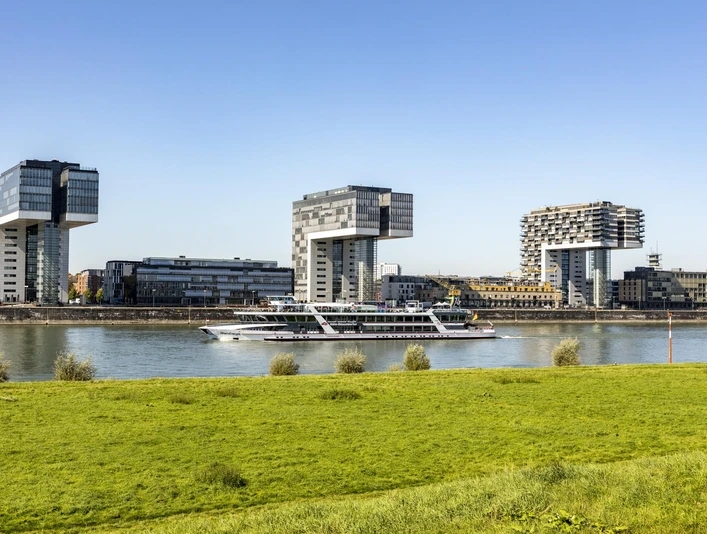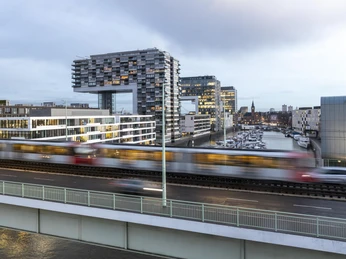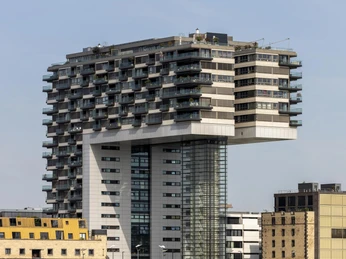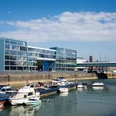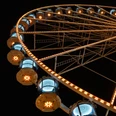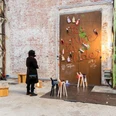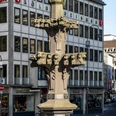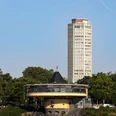Sporting lots of glass, concrete, steel and high tech, the Crane Houses impressively reflect our modern age. At the same time, they are striking symbols of the history of this site — through their association with the traditional loading crane that is often found in port facilities. Cologne’s Crane Houses thus combine the past and the present, industry and residential units, new beginnings and retrospectives, utility and art.
A place of pilgrimage for fans of state-of-the-art architecture
If you’re a fan of contemporary architecture that is sustainably shaping today’s cityscapes, you should put a visit to the Rheinauhafen on your list. As you stroll beneath the Crane Houses, each of which is supported by a glassed-in staircase column, you’ll have a unique and exciting chance to look at these buildings from the bottom up.Three Crane Houses: North, Middle, South
The three Crane Houses were built one after the other between 2006 and 2010. Only two of the three buildings look similar; they’re the ones that are used for commercial purposes. The protruding balconies of the third Crane House clearly show that it’s a residential building. All of the 133 luxury apartments in Crane House North were already sold before its construction was complete.The Crane Houses have different numbers of floors, but they are almost identical in height at 61.6 and 61.9 metres respectively, and are 70.2 metres long and 33.75 metres wide with a total utility and living space of 47,500 square metres.
The architects of the Crane Houses
The Crane Houses were designed by the Aachen-based architect Alfons Linster and the Iranian-German architect Hadi Teherani from Hamburg. Teherani was inspired by El Lissitzky’s cloud hanger designs. He’s also known for his “Dancing Towers” in Hamburg and the “Spin Tower” in Frankfurt.In 1992 these architects won the first prize in the idea competition for the redesign of Cologne’s Rheinauhafen. However, the foundation stone was not laid until 14 years later, after it had finally been decided to use a steel-frame structure for the Crane Houses. This is the same type of construction that is used for building bridges.
Who lives in the Crane Houses?
In the commercial parts of the Crane Houses you can find IT and consulting companies, bars, cafés, surgeries, creative and media agencies, law firms and restaurants such as Ox & Klee. The identities of the private individuals who live in Crane House North is a well-kept secret. It’s said that a number of celebrities such as Lukas Podolski have bought apartments there, but whether they actually live in them is unknown.A future-oriented concept
Not only the architecture but also the environmentally friendly technology concept are future-oriented. The buildings’ technology concept includes minimal energy consumption, an increased use of renewable resources and the smallest possible burden on the ecosystem. This is why the office building Crane House South was granted a gold certificate by the German Sustainable Building Council (DGNB).Good to know
Eligibility
Suitable for any weather
for Groups
for families
for individual guests
Suitable for the Elderly
Directions & Parking facilities
The Rheinauhafen can also be reached by buses operated by Kölner Verkehrsbetriebe (VRS). Line 133 goes to the "Rheinauhafen" stop, which drops you off directly at the Crane Houses.
Travelling by car is also possible. The Rheinauhafen multi-storey car park is the longest multi-storey car park in Europe.
General information
Parking Available
Bus stop available
Our recommendations
Nearby
